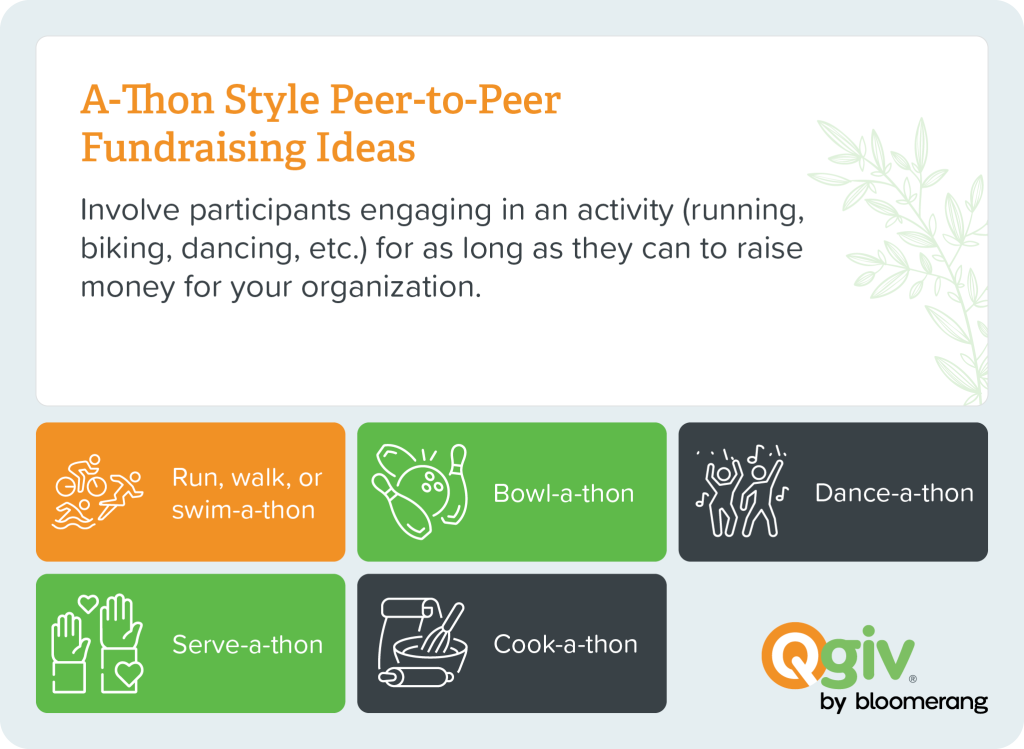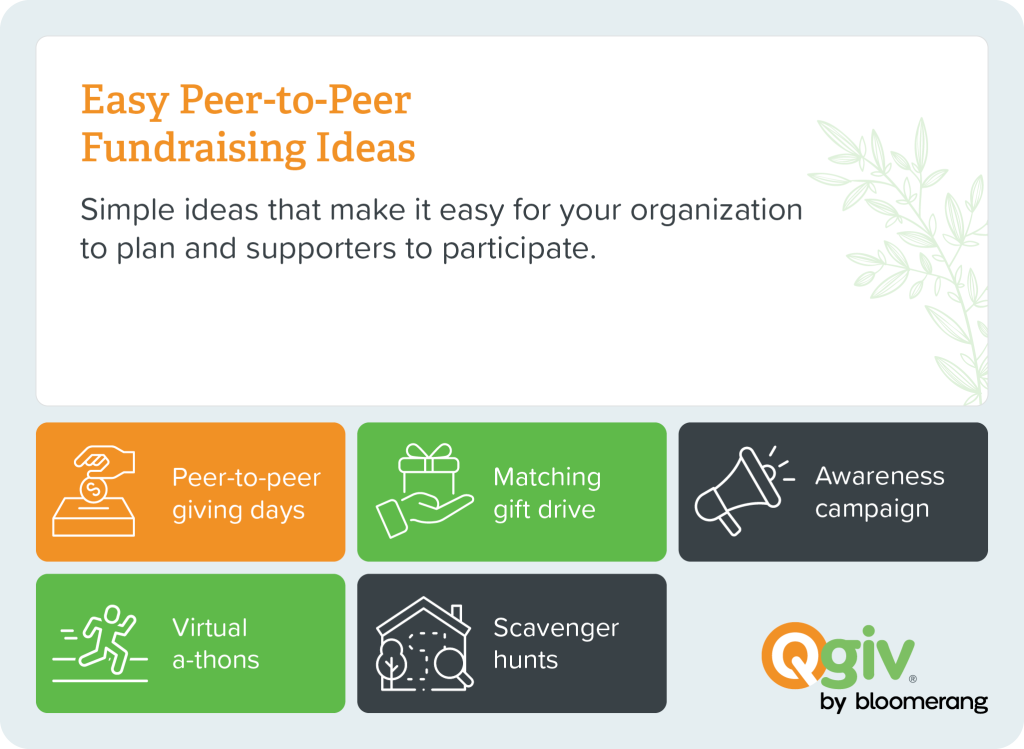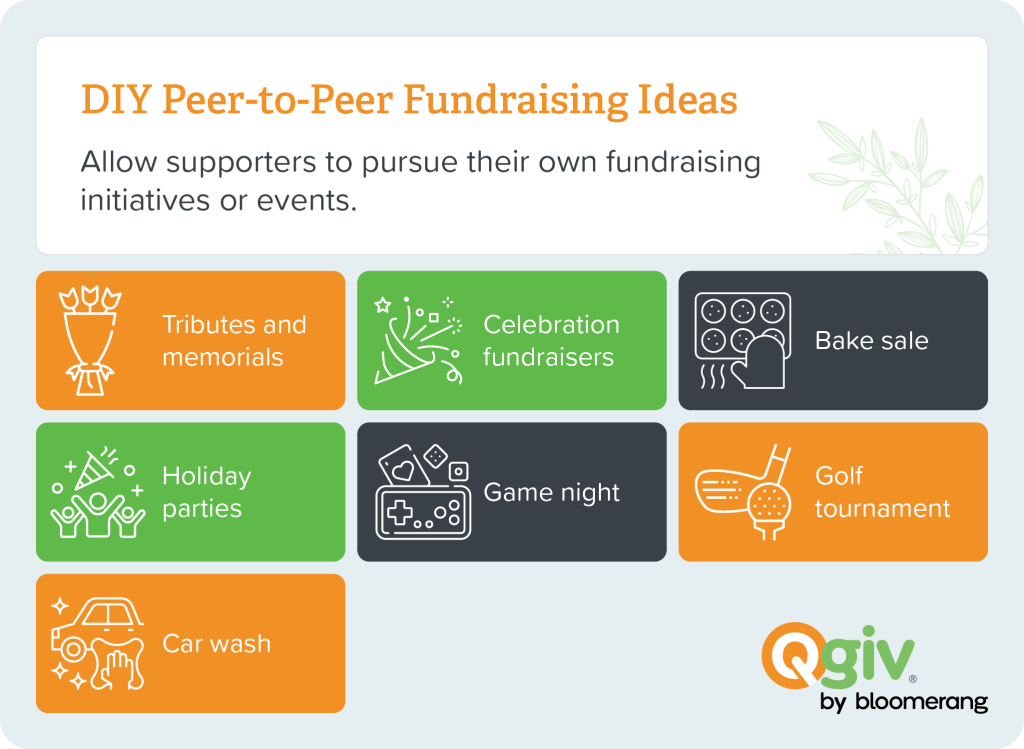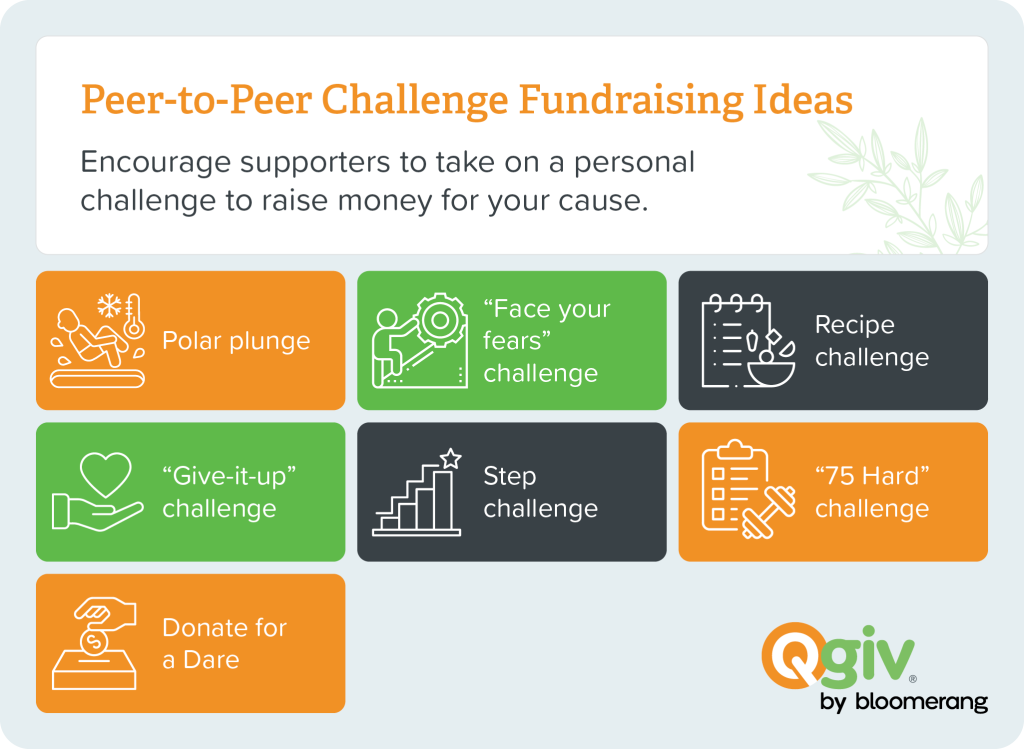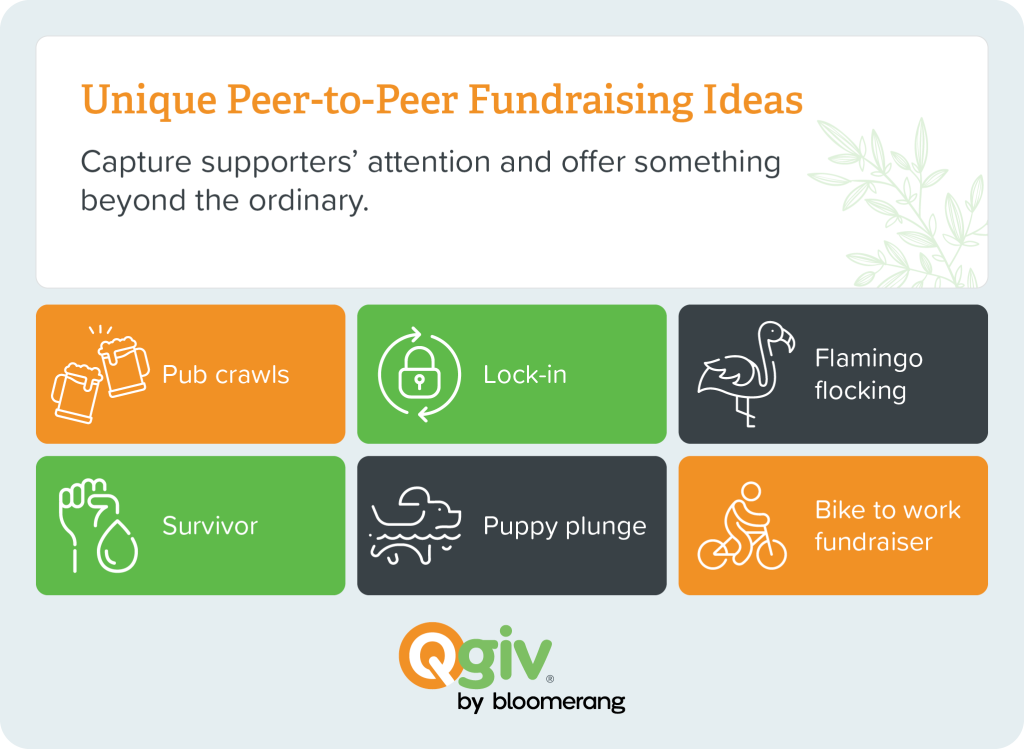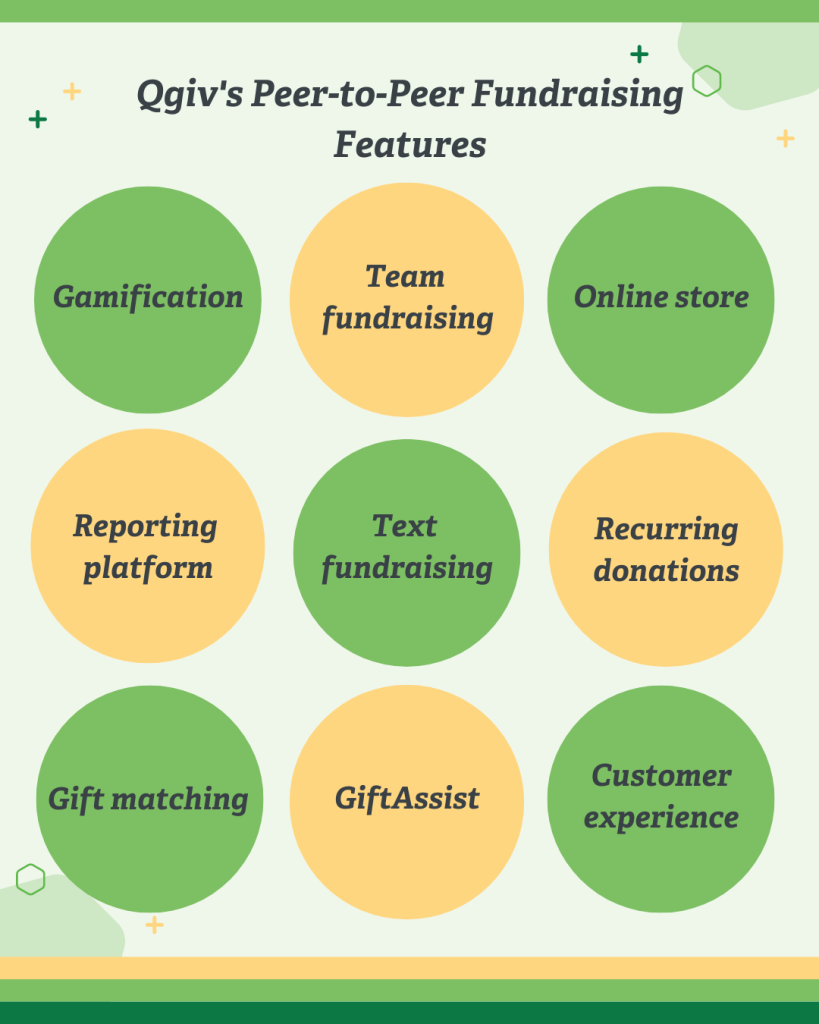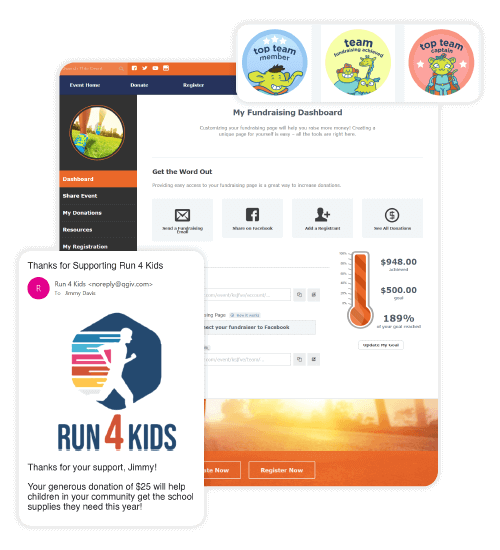Peer-to-peer fundraising—individuals raising money for a cause with the help of their family and friends—is a fun, easy, and lucrative strategy to attract awareness and generate funds for your cause.
Studies have shown that:
- Peer-to-peer fundraising initiatives average 39% success, compared to 22% for traditional fundraising.
- 75% of peer-to-peer donors are first-time donors.
- 56% of contributors are more willing to donate to a peer-to-peer campaign if they know someone already engaged in the campaign.
However, finding the right peer-to-peer fundraising ideas to suit your nonprofit’s needs and your audience’s interests can be challenging. That’s why we created this list of top peer-to-peer fundraising ideas to help you get started:
- A-Thon-Style Peer-to-Peer Fundraising Ideas
- Easy Peer-to-Peer Fundraising Ideas
- DIY Peer-to-Peer Fundraising Ideas
- Peer-to-Peer Challenge Fundraising Ideas
- Unique Peer-to-Peer Fundraising Ideas
- Tips to Choose the Right Peer-to-Peer Fundraising Idea
- How Qgiv + Bloomerang Supports Peer-to-Peer Fundraising
A-Thon Style Peer-to-Peer Fundraising Ideas
A-thon style events involve participants engaging in an activity (running, biking, dancing, etc.) for as long as they can, raising money for your organization throughout the event. The longer participants continue the activity, the more donations they raise to help reach your goal.
These peer-to-peer fundraising ideas are popular because they inspire friendly competition among participants. Explore our favorite a-thon style fundraisers.
Run. Walk. Swim.
When they think of peer-to-peer fundraising, most people think of athletic events. Runs, walks, and swims are very popular events, and you can easily sell team T-shirts to raise extra fundraising dollars. Hold your event annually and invite sponsors to have tents at the finish line with water/sports drinks and even craft beer for the finishers.
How to do it: After you’ve set up your event and arranged the details, invite your supporters to set up fundraising pages. They can share their page with friends and family, ask them to donate, or encourage them to register.
Bowl-a-Thon
This is a popular way to get teams together for friendly competition in a fun social environment. To get the competition going, suggest the teams come up with team names and offer a prize for the most creative ones. You can also include donated prizes for silly achievements like most “gutter balls” to take the pressure off your participants.
Tips and tricks: This is an awesome opportunity to encourage friendly competition between teams! Reach out to local businesses to see if they have groups of employees who would be interested in creating a team—it’s great for your nonprofit, an opportunity for them to bond with each other, and could lead to relationships with businesses down the road.
Dance-a-thon
Dance-a-thons or dance marathons are fun ways to raise money for any cause. Encourage your participants to create dance teams and host contests to see who can come up with the most fun routines.
How to do it: Most dance-a-thons or dance marathons are 24-hour events where participants raise as much money as they can in that time period. Usually, you’ll need to rent a space like a gymnasium or an area in a rec center that you can use for those 24 hours for your participants to gather and take part in activities together. If you don’t have access to that kind of space, it’s easy to take your dance-a-thon virtually! Encourage dance teams to gather in their own homes and dance together. You can even plan a livestream with a DJ to give them something to groove to.
Serve-a-thon
As a nonprofit organization, it’s likely that your supporter base has more than a few service-minded individuals. Give them the opportunity to better their communities while also raising money for your organization with a serve-a-thon.
How to do it: Over time, your peer-to-peer participants will tackle service projects near and dear to their hearts, all in the name of your organization. At the same time, they’ll solicit donations and pledges from their networks of family and friends for each service project they complete or hour of volunteer service they complete. This campaign can take place over several weeks to give everyone time to get their volunteer hours in or an even shorter period of time for more of a challenge.
Cook-a-thon
Calling all amateur chefs! This peer-to-peer cook-a-thon will challenge your participants’ creativity and put their cooking skills to the test. Ask your participants to share their favorite recipes on their individual peer-to-peer fundraising pages and post pictures of their completed dishes. They can try other people’s recipes or stick to their own.
Tips and tricks: This is a great fundraising idea for food banks to host with a fun twist! Give your participants a list of ingredients commonly found at food pantries and encourage them to come up with creative recipes using only those ingredients. Then, invite donors from their networks to vote on their favorite recipe or have an independent panel of judges do the judging. The winning recipes can be included in a food bank cookbook that your organization can sell as an additional fundraiser and handed out for free with food bank deliveries or pick-up orders to food bank recipients!
Easy Peer-to-Peer Fundraising Ideas
Easy peer-to-peer fundraisers don’t require much work from your organization or supporters. They’re simple and cost-effective to get started with, meaning they can drive a high return on investment (ROI). Read on for effective, easy peer-to-peer fundraising ideas to engage your audience.
Peer-to-peer giving days
Over a 24-hour period, your participants will reach out to their networks to ask for donations on behalf of your organization and raise as much money as they can. To encourage participation, add an element of competition by encouraging people to sign up as teams and compete to see who can raise the most money in those 24 hours.
How to do it: Pick a day that’s meaningful to your organization, like your founding anniversary or a larger community-wide giving day, if one exists. In the weeks leading up to your giving day, spread awareness of the day and recruit fundraisers. Then, have your participants set up their own individual fundraising pages and advertise the campaign on their social media networks.
Matching gift drive
Matching gifts are statistically proven to increase people’s likelihood of donating, making a matching gift drive a highly successful peer-to-peer fundraiser for many organizations. In fact, in one survey, 84% of participants said they’re more likely to donate if a match is offered.
Once you recruit a sponsor or multiple sponsors, all your participants need to do is share the fundraiser with their networks and mention that any gifts made will be matched! Make sure your participants are fully in the loop about who your sponsors are and if there are any restrictions on matching gifts so they can give their family and friends accurate information.
How to do it: Reach out to past sponsors or local businesses to see if they’d be willing to get involved in your matching gifts drive. They might match gifts up to a certain amount or over a certain period of time. You can also see if your participants have sponsors they can bring to the table who would sponsor individual participants instead of your entire fundraising campaign.
Awareness campaign
Your organization’s mission is to make the world a better place, but part of that mission involves educating people about your cause and spreading awareness. With a peer-to-peer awareness campaign, you can center your mission and expand your reach to new audiences. Your participants will promote your organization to their family and friends, including detailed information about what your organization does, how you do it, and why it matters.
Tips and tricks: Recruiting the right type of peer-to-peer participants is crucial to the success of an awareness campaign. Your ideal peer-to-peer participants will be your most passionate and involved supporters. If they don’t already have in-depth knowledge about your nonprofit’s work, you’ll need to take the time to educate them so they can share the right information with their networks. Personal appeals are great for this kind of campaign, so make sure they also share why your organization matters to them and why they’re willing to put in the time and effort to raise money on your behalf.
Virtual a-thons
It’s no secret that organizing a peer-to-peer fun run, walk-a-thon, or any type of “a-thon” event takes lots of time and effort. With a virtual a-thon event, you can take some of the hassle out of planning your fundraising campaign! Instead of gathering your participants on a particular day or needing to gather in person at all, your fundraisers can participate in your campaign on their own time from wherever they are.
How to do it: Like any other peer-to-peer a-thon event, you’ll create a website, and participants will have their own individual fundraising pages where they can collect donations from their family members and friends. However, they’ll be completing challenges or participating in your event from the comfort of home! To encourage participation and take some stress out of the campaign, you can designate a period of time when they can complete their 5K or read books or whatever your fundraiser is designed around. Then, they can log their progress on their personal fundraising pages and share it with their networks until the campaign is completed.
Scavenger hunts
Fun for the whole family, a peer-to-peer scavenger hunt is a great fundraiser for any organization. In the weeks leading up to the big hunt, your participants will fundraise online and invite their donors to help them complete the hunt as well! You can place hints around your community for an in-person event or provide your participants with a list of items to find or tasks to complete that are easy for people no matter where in the world they’re located.
Tips and tricks: With a tool like Eventzee, it’s super easy to create and customize a scavenger hunt for your organization’s fundraising event. You can create engaging scavenger hunts specific to your location or even for educational purposes! People will be able to submit completed challenges or clues they’ve found directly on the platform, so you don’t have to worry about manually keeping track of everyone’s progress.
DIY Peer-to-Peer Fundraising Ideas
DIY peer-to-peer fundraisers empower supporters to create their own fundraising initiatives or events based on their personal interests. They can plan these events on their own time and promote them to their networks. This list contains creative DIY fundraising ideas.
Tributes and memorials
Starting a peer-to-peer fundraiser in someone’s honor is a powerful way to focus your fundraising on the personal story of an individual supported by your organization.
How to do it: Set up a peer-to-peer event that allows people to create pages honoring their loved ones. Give them the tools to share their page, but let them take the lead on how they want to spread the word.
Celebration fundraisers
Have wedding or birthday guests ask for donations to your charity rather than gifts. People can also set up a fundraising page where their family and friends can donate instead of buying something from a registry or a birthday wishlist, and they can leave their well-wishes for the couple or birthday person right on the fundraising page.
How to do it: This setup can be similar to a fundraiser for a loved one. Set up a peer-to-peer event that allows individuals to create a page for a specific life event. Give your celebrating supporters the tools they need to explain why they’re supporting your organization on their special day.
Bake sale
Bake sales never go out of style. Who doesn’t love buying treats that benefit a worthy nonprofit organization? Expand your participation by offering more healthy gluten-free and low-sugar alternative choices. Exchange yummy treats for donations at schools and churches.
Tips and tricks: Ready for more friendly competition? Ask each fundraiser to bring in their favorite baked good for donors to sample. Donors then “vote” on who brought the best goodies by donating to their fundraising page. Each vote is $1 — and any remaining food can be sold to donors who couldn’t get enough.
Holiday parties
Participants can set up fundraising pages to share with friends and family as the event approaches. Then, at your party, acknowledge outstanding participants and donors. You can also include auctioned items and special “live” auction items to make your party more entertaining for your guests.
How to do it: You can approach this fundraising idea in several different ways. Run it as a traditional peer-to-peer event and hold the holiday party as the culmination of the fundraiser. Alternatively, you could encourage participants to get as many friends and family members as possible to “sell” admittance to the party in return for a donation. Get creative!
Game nights
Casino nights are popular events to raise money for your cause. Have them register for a donation fee and exchange it with fake money and award prizes for those with the biggest wins of the night. Offer a way to donate money to your online peer-to-peer event.
How to do it: You can approach this the same way you promote a holiday party. If you use tools like text fundraising for your peer-to-peer event, participants can encourage their attending friends and family to donate and get more chips just by texting the participant’s unique keyword to your number.
Golf tournament
Annual golf outings are a great fundraising idea. Teams are important here; they can work together to raise more money leading up to the tournament and recruit other people to participate. Bring in sponsorships to host prizes or recognition for achievements like “closest to the hole” and “hole in ones” to add to the competition. Be sure you recruit a lot of volunteers to offer additional raffle items during the event.
How to do it: Is there anything more classic than a golf tournament fundraiser? This can work exactly like the tournaments that have been going on for decades. However, you can have participants collect pledges and donations online instead of in person.
Car wash fundraiser
A classic car wash fundraiser is never a bad way to go for a fundraising campaign! Recruit your peer-to-peer car washers and designate a day for your community car wash. In the weeks leading up to the big wash, your participants can collect donations and pledges from their community members based on how many cars they help wash or how many hours they work to wash cars. If donors are intending to attend the car wash, they can also give in anticipation of that.
How to do it: The trickiest part of hosting a car wash is finding a place to do it. You’ll need access to a good water supply, and if you’re including inside car cleaning, you’ll also need access to electrical outlets for vacuum cleaners. Some car washes are very willing to lend their facilities to organizations looking to raise money, so reach out to car washes in your area to see if they have any days off they can give to your organization! Otherwise, be prepared to bring any long hoses and electrical cord extensions to whatever venue you choose for your car wash!
Peer-to-Peer Challenge Fundraising Ideas
Challenge fundraisers encourage supporters to take on a personal challenge to raise money for your cause. They’ll collect pledges ahead of time that translate into donations upon successful challenge completion. Here are some examples of these fun peer-to-peer campaigns.
Polar plunge
Getting outside in the winter can be difficult in colder areas. But for those willing to go the extra mile for a good cause, a polar plunge is a great challenge to pose to your daring supporters! You can either plan this fundraiser as a virtual challenge for people to complete on their own time in their own pools or bathtubs or gather everyone to take the plunge together.
How to do it: If you’re hosting an in-person event, find a beach or a local lakeside where you can safely hold your polar plunge. You’ll need to reach out to the managing entity of your polar plunge location to receive the necessary permits and rules for hosting your fundraiser. Make sure to have medical personnel and lifeguards on hand to help anyone who may need assistance before, during, or after the plunge for a safe and fun event. After everyone makes it out of the water, designate a space where your participants can all warm up and take part in some fun, celebratory activities.
“Face your fears” challenge
For this peer-to-peer challenge, it’s time to push your supporters out of their comfort zones! Ask your participants to reach out to their families and friends to raise money in support of your organization and their mission to face their fears.
How to do it: Your participants should designate a few things that give them anxiety that they want to go up against at the conclusion of the campaign, whether it’s something like a fear of heights or a mental challenge like a fear of rejection. They can designate various fundraising milestones and assign different fears to each one. When they reach a milestone, they should go out and face that fear in some way, documenting their experience and sharing it with the people who have donated to the campaign. Just make sure to set some rules to ensure that everyone is completing their challenges safely!
Recipe challenge
Do your supporters enjoy cooking or experimenting with food? For this recipe challenge, it’s time for your participants to head to the kitchen and put on their chef hats. Whether it’s a cherished family recipe or an attempt to recreate their favorite meal from a beloved restaurant, encourage your participants to share their love of food with this delicious peer-to-peer fundraiser.
How to do it: On their individual peer-to-peer fundraising pages, have your participants write down their favorite recipes. Have them share the fundraising campaign with their networks via social media, email, or whatever channel of communication they like best, with a note for their family and friends to try a few recipes from a few different participants. Once they’ve taken to their kitchens and tried a few meals, they can vote for their favorite recipes by donating to the respective peer-to-peer fundraising pages. Whoever’s raised the most money by the end of the campaign wins a prize.
“Give-it-up” challenge
For this peer-to-peer fundraising challenge, encourage your participants to give up something that they enjoy and put the money they save towards your organization. They can challenge themselves to forgo something like their daily cup of coffee or a meal out with friends for a period of time. During that time, they can substitute their spending by making coffee at home or cooking a healthy meal at home, all while supporting your organization by donating the money they save by making those substitutions.
Tips and tricks: Help your participants double their impact by challenging their networks to also give something up. While family and friends can show their support for your fundraisers by making donations or pledges based on how much or for how long your participants give up, they can also take part in the challenge themselves by donating what they save by giving up a regular expenditure of their own.
Step challenge
Get your participants up and moving with a step challenge! Set a goal for your participants to meet over a period of time or challenge them to meet a step goal every week or every day. They can collect pledges from their networks that support them in this challenge based on how often they meet their goals or how many steps they take, and they can collect those pledges once they’ve completed the challenge.
Tips and tricks: Your participants will need a way to track their steps throughout the challenge, so make sure to provide them with a few resources to do that. Some of your participants might have step counters or smartwatches that count steps for them, while others may just count on their smartphones’ built-in step counters to do the job for them. If your participants aren’t confident about using that feature, make sure to have a few recommended apps on hand for them to get easy access to their step data.
“75 Hard” challenge
Are your supporters ready to build new healthy habits? Studies show that it can take anywhere from 18 to 254 days for a person to form a new habit and about 66 days for a new behavior to become automatic. With the 75 Hard challenge, your peer-to-peer participants will choose five activities to complete every day for 75 days that serve to make them healthier in both mind and body. As they complete the challenge, they’ll fundraise for your organization and keep their donors updated on their progress by posting updates on their personal fundraising pages.
Tips and tricks: For some people, the 75 Hard rules can be difficult to maintain in their everyday lives without getting discouraged. Fundraisers should be fun, so encourage your participants to pick five habits they want to change that are reasonable for their lifestyle, like drinking more water or getting outside for a few minutes every day. If 75 days is too daunting of a timeline, that’s okay too! You can make this challenge as long or as short as you want. Keep your participants motivated by creating a positive community of support and give them tips, tricks, and tools for reaching both their fundraising and lifestyle goals.
Donate for a Dare
For the daredevils in your supporter base, a “donate for a dare” challenge is a fun way to raise money for your organization. Have your participants establish donation levels and assign a type of dare to each one. Every time someone donates or makes a pledge to their personal fundraising pages, they can request the participant complete a dare, giving them the opportunity to have some fun and raise money for your mission at the same time!
Tips and tricks: With a challenge like this, it’s important that everyone stays safe and has fun. Before your campaign starts, establish rules and set boundaries for your participants and donors so people aren’t requesting dares that put anyone in danger.
Unique Peer-to-Peer Fundraising Ideas
A unique peer-to-peer fundraising campaign captures supporters’ attention and offers something beyond the ordinary. Consider the following unique ideas ahead of your next campaign.
Pub crawls
Get locals together for a pub/coffee/dessert crawl around your town. Ask businesses ahead of time if they can offer any discounts for your event. Make it more fun by adding a theme and wearing costumes around a holiday like Halloween, Valentine’s Day, or the Fourth of July.
How to do it: This is an excellent incentive for peer-to-peer fundraisers. It’s also the perfect opportunity to recognize top fundraisers! Announce winners for each fundraising category at each new spot: think of categories like top team, top fundraiser, best fundraising page, etc.
Lock-in
Give parents a night off and plan a fun night for the kids with a lock-in fundraiser! Your lock-in participants will enjoy a fun night with their friends while working together to raise money for your organization. You can add a fun theme and make it a pajama party or include fun activities like an obstacle course to make it an even more memorable fundraiser for participants.
How to do it: Make sure to advertise your lock-in in the weeks leading up to the event so parents can sign their kids up and kids can spread the word about the fundraiser to their family and friends. Designate a room like the school gymnasium where your lock-in will take place, and you can easily supervise all of the kids. It can be an overnight lock-in or just a few hours at the end of the school day. Organize activities and make sure to document all the fun on social media so donors can see it for themselves!
Flamingo flocking
Flamingo flocking is a unique way to raise money for your organization that is sure to get some laughs. Give your participants a plastic flamingo flock of their own and get them started by flocking someone’s yard. Once that person makes a donation to your participants’ personal fundraising pages, they can pick the next flocking victim. Your participants will pick up the plastic flamingos and pass on the fun.
Tips and tricks: Before getting started, advertise your fundraiser thoroughly so people in the community are aware that it’s happening! Every flock should be left with a note explaining what the participant is raising money for and with a link to their personal fundraising page.
Survivor
It’s time to test your supporters’ team-building skills! A “Survivor” fundraiser is a multi-week or multi-day peer-to-peer campaign in which your participants create teams and complete challenges together or get voted off the “island.” Make sure every challenge is documented extensively on social media so donors can keep up with the competition and cheer their fundraising friends and family members on.
How to do it: Have each team make their own personal fundraising pages and team fundraising page. When you pose each challenge, give teams a timeframe to complete the challenge. They should take photos and videos to submit and post on their fundraising pages and social media to prove that they’ve completed the challenge. Their networks can donate to keep them in the competition or help them win special benefits like immunity or boosts during challenges!
Puppy plunge
Some dogs just love a dip in the pool, so why not let them jump in for a good cause? A puppy plunge is a cute fundraising idea for animal shelters or animal lovers in your supporter base. In the weeks before the designated plunge day, your participants will raise money from their networks for your organization. Then, invite everyone to bring their furry friends to the pool or lake and let them go wild together. Don’t forget to take plenty of photos and videos to commemorate the moment.
Tips and tricks: This fundraiser works great as a virtual fundraiser for pet owners to do at their own homes or at the nearest body of water. However, if you’re planning to hold it as an in-person event, find a place where dogs can safely run wild into a body of water. Some pools might be willing to let your organization use their facilities at the end of the summer pool season and before they drain their pools, so don’t be afraid to reach out and ask.
Bike to work fundraiser
It’s time to reduce those carbon emissions and get in a good workout with a bike-to-work fundraiser! If your participants can safely do so, organize a week during which they pledge to bike to work or school instead of driving. When they fundraise, donors will make pledges based on the mileage participants bike or donate for every day that they successfully bike to work.
Tips and tricks: If you don’t live in a bike-friendly community, consider using public transportation as an alternative to biking. For kids who want to bike to school, you can also recruit volunteers who can organize a bike train or ask parents to team up with other parents to escort kids so everyone gets safely to school.
In addition to these ideas, there are new fundraising ideas that are taking off virally in social media at a more frequent pace than we have ever seen. Considering the speed with which ideas are shared, you merely need to pay attention to what’s trending. And a great place to start is with your donors!
Tips to Choose the Right Peer-to-Peer Fundraising Idea
We’ve outlined plenty of options here to consider for your fundraisers. But which campaigns will work best for your unique organization? Use these tips to help choose the right fundraising ideas:
Align your fundraisers with your mission.
Ensure your peer-to-peer fundraising campaigns make sense in the larger context of your organization’s mission. For example, an animal shelter may host a puppy plunge fundraiser to keep participants focused on the core purpose of the event.
Get donors’ input.
Listen to what your donors talk about, like, and share on social media. Ask your existing donors, volunteers, and other event participants for feedback and ideas on different campaign options. Create a social media poll or send an email survey to gather input.
Consider your community’s unique traits.
Every community has unique attributes that make it a perfect environment for your next fundraising idea. Are you near a walkable downtown, a painting or pottery studio, a nice restaurant, or even a bowling alley? These places provide excellent venues for getting people together to raise money for your organization. If your donors are already excited about something local, they’ll be more likely to get involved with a peer-to-peer fundraiser that incorporates it.
Keep the time of year/season in mind.
Polar plunge events aren’t great for summertime, and outdoor scavenger hunts wouldn’t work well in the chilly winter months. You may also want to align your campaign with a holiday or a day relevant to your organization’s mission, so remember those dates when planning your fundraisers.
Include local businesses.
Don’t be shy to ask local businesses for campaign ideas and if they’re interested in participating. These businesses typically love opportunities to bring in more customers and participate in community-friendly activities.
If you partner with businesses to host your events, prominently display their logos online and in signage throughout your event. Invite them to milestone check-ins and the final event, and personally thank them for supporting your organization.
How Qgiv + Bloomerang Supports Peer-to-Peer Fundraising
Qgiv by Bloomerang is a fundraising platform that makes it easy to execute fun, creative fundraising events and campaigns, engaging plenty of supporters along the way. No matter what type of event or campaign you’re hosting, Qgiv enables you to create a branded event page to easily promote the initiative. Additional features to support fundraising include:
- Gamification features, including badges and prizes for top fundraisers
- Team fundraising tools, including team leaderboards, recruitment and fundraising goals for each team, and the ability to assign captains
- An online merchandise store to open an additional revenue stream during your campaign
- Reporting tools to monitor donations, event registrations, purchases, and supporter activity to evaluate event success and identify opportunities for improvement
- Text fundraising features to keep participants and donors informed and engaged in campaign progress
- Recurring donation functionality so donors can turn one-time gifts into ongoing support
- Gift matching via employee matching gift programs
- GiftAssist to allow donors to cover processing fees for transactions
- Customer experience tools, including phone, email, and live chat customer support for questions or concerns
This platform prioritizes supporter-first experiences with personal fundraising dashboards, custom badges, and personalized outreach.
Final thoughts
We hope this roundup of top peer-to-peer fundraising ideas inspired you! Looking for additional resources to support your campaign? Start here:
- 15 Top-Rated Nonprofit Peer-to-Peer Fundraising Platforms. The right technology can make or break your fundraising efforts. Explore top peer-to-peer fundraising platforms to consider for your campaigns.
- The Expert Volunteer Management Guide for Savvy Nonprofits. Need to recruit and manage volunteers to help run peer-to-peer fundraising events? Use this guide for tips on managing your volunteers effectively.
- Mobile Giving Crash Course: Essential Guide for Nonprofits. Peer-to-peer fundraising increasingly takes place via mobile devices. This comprehensive guide explains mobile giving in more detail.

